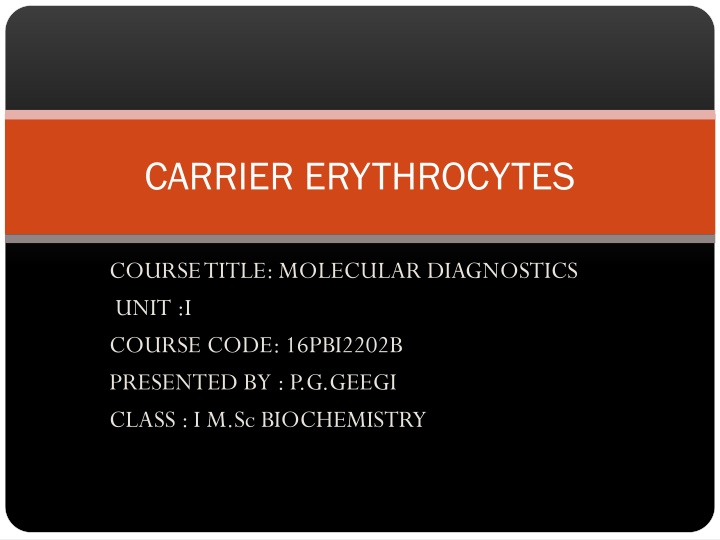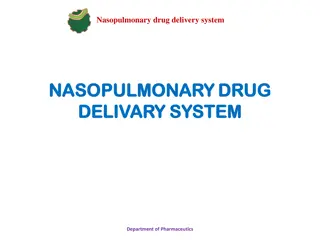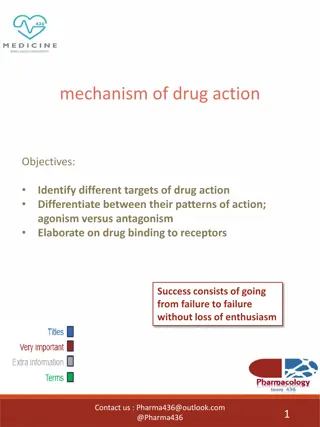Advantages of Carrier Erythrocytes in Drug Delivery
Erythrocytes, the main carriers of oxygen in the body, can be utilized as carriers for drug delivery due to their biocompatibility and ability to protect drugs from premature degradation. They offer advantages such as targeted drug delivery, sustained release of drugs, and protection against toxic effects. Encapsulation within erythrocytes modifies pharmacokinetic parameters and allows for the delivery of a variety of compounds with high biotechnological potential.
Download Presentation

Please find below an Image/Link to download the presentation.
The content on the website is provided AS IS for your information and personal use only. It may not be sold, licensed, or shared on other websites without obtaining consent from the author.If you encounter any issues during the download, it is possible that the publisher has removed the file from their server.
You are allowed to download the files provided on this website for personal or commercial use, subject to the condition that they are used lawfully. All files are the property of their respective owners.
The content on the website is provided AS IS for your information and personal use only. It may not be sold, licensed, or shared on other websites without obtaining consent from the author.
E N D
Presentation Transcript
CARRIER ERYTHROCYTES COURSE TITLE: MOLECULAR DIAGNOSTICS UNIT :I COURSE CODE: 16PBI2202B PRESENTED BY : P.G.GEEGI CLASS : I M.Sc BIOCHEMISTRY
Erythrocytes or red blood cells constitute the largest population of blood cells and are the main carriers of oxygen to the body cells and tissues. Erythrocytes contain high concentrations of iron-rich haemoglobin. The mature form is normally a non-nucleated, yellowish, biconcave disk with a central pallor. The biconcave shape provides a large surface-to-volume ratio for oxygen delivery and better flexibility in narrow capillaries. Erythrocytes have a life of around 120 days, later they degenerate and are destroyed by the spleen
Erythrocytes have two main purposes To act as a reservoir for the drug, providing the sustained release of the drug into the body. To selectively direct the drugs to the R.E system of the liver, spleen and bone marrow, which constitute the usual sites for the destruction of erythrocytes
Advantages of carrier erythrocyte A remarkable degree of biocompatibility The drug encapsulated in the erythrocytes does not show its pharmacological and toxicological function until it reaches the reticulo-endothelial system such as antineoplastics, amino glycoside antibiotics etc. Erythrocytes are easy to handle. Avoidance of any undesired immune responses against the encapsulated drug.
Considerable protection of the organism against the toxic effects of the encapsulated drug, e.g., antineoplasms. Long life-span of carrier erythrocytes in circulation in comparison to the synthetic carriers. Encapsulation within the erythrocytes provides the drug with a systemic clearance similar to the normal life of the erythrocytes. The substance encapsulated within the erythrocytes is protected from premature degradation and avoids immunological reactions.
Protection of the loaded compound from inactivation by the endogenous factors. Possibility of targeted drug delivery to the R.E systems organs. Possibility of ideal zero-order kinetics of drug release. Wide variety of compounds with the capability of being entrapped . Possibility of loading a relatively high amount of drug in a small volume of erythrocytes. Modification of the pharmacokinetic and pharmacodynamic parameters of the drug. They permit the encapsulation of peptides of high mol weight with significant biotechnological applications.
Disadvantages: The major problem encountered in the use of biodegradable materials or natural cells as drug carriers is that they are removed in-vivo by the RE cells. This seriously limits their useful life as drug carriers and in some cases may pose toxicological problems. The rapid leakage of certain encapsulated substances from the loaded erythrocytes. Encapsulated erythrocytes may present greater variability and lesser standardization in their preparation,
compared to other carrier systems. The storage of the loaded erythrocytes is a problem. Tests have been performed on their conditioning in suspension in isotonic buffers. Liable to biological contamination due to the origin of the blood, the equipment and the environment, such as air. Rigorous controls are required accordingly for the collection and handling of the erythrocytes.
SOURCE AND ISOLATION OF ERYTHROCYTES Different mammalians human, monkey, horse, sheep, goat, rabbit etc., are used for the collection of erythrocytes. To isolate erythrocytes, blood is collected into heparinised tubes by venipuncture. EDTA or heparin can be used as an anticoagulant. Fresh whole blood is defined as any blood collected and immediately chilled to 40C and stored for not more than 2 days.
After recovering the blood from vein puncture and mix with heparin, it is centrifuged at 2000 gm for 5 min at 4 1 0C.This helps in separation of plasma and Buffy coat. Erythrocytes so obtained are washed with buffer solution. These erythrocytes are often stored in acid-citrate- dextrose buffer at 4 0C up to 48 hrs.
METHODS OF DRUG LOADING METHODS OF DRUG LOADING Several methods can be used to load drugs or other bioactive compounds in erythrocytes, including physical (electrical pulse method) osmosis-based systems, and chemical methods (chemical perturbation of the erythrocytes membrane). Hypotonic dilution. I. II. Hypotonic preswelling. III. Hypotonic dialysis.
Isotonic osmotic lysis . I. II. Chemical perturbation of the membrane. III. Electro-insertion or electro encapsulation. IV. Entrapment by endocytosis. V. Hypotonic haemolysis. I) Hypotonic haemolysis is based on reversible swelling in a hypotonic solution. An increase in cell volume its shape changed from biconcave to the spherical.
The cells assume a spherical shape to accommodate additional volume while keeping the surface area constant. The volume gain is ~25 50%. The cells can maintain their integrity up to a tonicity of ~150 mosm/kg, above which the membrane ruptures, releasing the cellular contents. After cell lysis, cellular contents are released. The remnant is called an erythrocyte ghost.
II) Hypotonic dilution was the first method investigated for the encapsulation of chemicals into erythrocytes and is the simple and fast Hypotonic dilution was the first method investigated for the encapsulation of chemicals into erythrocytes and is the simple and fast A volume of packed erythrocytes is diluted with 2 20 volumes of aqueous solution of a drug. The solution tonicity is then restored by adding a hypertonic buffer.
RES organs. Hypotonic dilution is used for loading .The resultant mixture is then centrifuged, the supernatant is discarded and the pellet is washed with isotonic buffer solution The major drawbacks of this method include low entrapment efficiency and a considerable loss of haemoglobin and other cell components. This reduces the circulation half life of the loaded cells. These cells are readily phagocytised by RES macrophages and hence can be used for targeting enzymes such galactosidase and glycosidase, asparginase, and arginase, as well as bronchodilators such as salbutamol
III) This method is simpler and faster than other methods, causing minimum damage to cells. Drugs encapsulated in erythrocytes using this method include propranolol, methotrexate, insulin, metronidazole, levothyroxine, elaprnailat, and isoniazid. The technique is based upon initial controlled swelling in a hypotonic buffered solution. This mixture is centrifuged and the supernatant is discarded and the cell fraction is brought to the lysis point by adding 100 120.
IV) In this process, an isotonic, buffered suspension of erythrocytes with a hematocrit value of 70 80 is prepared and placed in a conventional dialysis tube immersed in 10 20 volumes of a hypotonic buffer. The drug to be loaded can be added by either dissolving the drug in isotonic cell suspending buffer inside a dialysis bag at the beginning of the experiment or by adding the drug to a dialysis bag after the stirring is complete.
In this method, the erythrocyte suspension and the drug to be loaded were placed in the blood compartment and the hypotonic buffer was placed in a receptor compartment. This led to the concept of continuous flow dialysis .eg galactosidase, glucose rebrosidase, asparginase, inositol hexa phosphatase, as well as drugs such as gentamicin, Adriamycin, pentamidine and furamycin, interlukin-2, desferroxamine, and human recombinant Erythropoietin.
Isotonic osmotic lysis: This method, also known as the osmotic pulse method, involves isotonic haemolysis that is achieved by physical or chemical means. If erythrocytes are incubated in solutions of a substance with high membrane permeability, the solute will diffuse into the cells because of the concentration gradient. This process is followed by an influx of water to maintain osmotic equilibrium.
Chemicals such as urea solution, polyethylene glycol, and ammonium chloride have been used for isotonic haemolysis.
VII) The method is based on the electrical shock which brings about irreversible changes in an erythrocyte membrane. The membrane is opened by a dielectric breakdown. Subsequently, the pores can be resealed by incubation at 37C. The compound to be entrapped is added to the medium in which the cells are suspended. The characteristic pore diameter created in the membrane depends upon the intensity of electric field, the discharge time, and the ionic strength of suspending medium.
The procedure involves suspending erythrocytes in an isotonic buffer in an electrical discharge chamber. A capacitor in an external circuit is charged to a definite voltage and then discharged within a definite time interval through cell suspension to produce a square wave potential. The optimum intensity of an electric field is between 1 10 kW/cm and optimal discharge time is between 20 160m. Entrapment efficiency of this method is 35%. Various compounds such as sucrose urease, methotrexate, isoniazid, DNA fragments, and latex particles of diameter 0.2 can be.
encapsulated by this method VIII) The entrapment of material occurs by endocytosis. It involves the addition of one volume of washed erythrocytes to nine volumes of buffer containing 2.5 mM ATP, 2.5 mMMgCl2, and 1mM CaCl2, followed by incubation for 2 min at room temperature. The pores created by this method are resealed by using 154 mM of NaCl and incubation at 370C for 2 min. The vesicle membrane separates endocytosed material from cytoplasm thus protecting it from the erythrocytes
and vice-versa.eg primaquine and related 8amino quinolines,vinblastine, chlorpromazine and related phenothiazines, hydrocortisone, propranolol, tetracaine, and vitamin A. Erythrocyte endocytosis produced by cations and trapping of molecules in the invagination or inside out endocytic vacuoles.
THERAPEUTIC APPLICATIONS OF CARRIER RED BLOOD CELLS One potential application is the delivery of (drugs, enzymes, nucleic acids, to cells responsible for or capable of erythrophagocytosis, which are located primarily in the liver and spleen. A second potential application depends on the ability of loaded cells to survive for substantial periods of time in the circulation after reinfusion.
ERYTHROCYTES AS DRUG CARRIERS- Antineoplastic drugs,Actinomycin D, Daunomycin,Etoposide, Carboplatin, Enalaprilat, Gentamicin, Primaquine, Metronidazole, Systemic corticosteroids like (Dexamethasone), Iron chelators, Prodrugs and Antioxidant drugs. ERYTHROCYTES AS ENZYME CARRIERS: Alcohol dehydrogenase , aldehyde dehydrogenase, Urokinase, Hexokinase and glucose oxidase,
Lactate-catabolising enzymes, Glutamate dehydrogenase,. Uricase, Rhodanase, Recombinant phosphortriesterase, urease and Alglucerase. ERYTHROCYTES AS CARRIERS OF PEPTIDES AND PROTEINS: Anti-HIV peptides , Antineoplastic peptides, Erythropoietin , Heparin , Interleukin 3 , Vaccines.
REFERENCES https://www.ncbi.nlm.nih.gov/pubmed/12554359 https://www.ncbi.nlm.nih.gov/pubmed/24456118 https://www.sciencedirect.com/science/article/pii/S01683 65906007085. Europepmc.org/abstract/MED/17270305.























